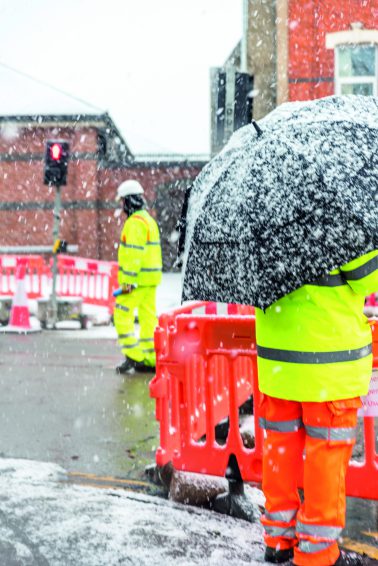Working in a Winter Wonderland
 Working during wintery weather conditions can increase the risk of a workplace accident with even the simplest tasks becoming dangerous. Strong winds, snow, ice, rain and freezing temperatures call for a fresh approach to health and safety when working in winter.
Working during wintery weather conditions can increase the risk of a workplace accident with even the simplest tasks becoming dangerous. Strong winds, snow, ice, rain and freezing temperatures call for a fresh approach to health and safety when working in winter.
Assess the risks
Employers have a legal duty to protect the welfare of employees and are responsible for managing health and safety. Following a simple five-point plan will enable employers to assess the risks of working outside during winter months. Taking preventative measures will mitigate risks.
As an employer, you should be considering the following six aspects of every potential winter hazard:
- Elimination – is it possible to eliminate the time that an employee spends working outside during winter?
- Substitution – is it possible to reduce the time that an employee spends working outside during winter?
- Engineering controls – can vehicles or other forms of equipment make working in the winter and during darker hours easier?
- Administrative controls – are there any procedures that can make winter working safer for your staff? Consider installing photoluminescent signage and performing further risk assessments.
- Personal Protective Equipment (PPE) – make sure employees have access to all appropriate PPE when working in winter conditions outside. High-visibility clothing, warm/waterproof workwear, torches, headlights, personal alarms are a good starting point.
The first four measures are crucial to risk assessment and PPE shouldn’t be viewed as a health and safety shortcut. Only when the previous measures have controlled risks to a reasonable level and are no longer effective should PPE become the focus.
Work safe
Winter weather is often unpredictable and hazardous. Extended exposure to low temperatures increases the risks of an accident. Employees working outside during this time should always have access to facilities that will allow them to get warm, rest and make hot drinks.
Wind chill is often overlooked so it can be difficult to determine the “feels like” temperature before venturing out. This can lead to greater heat loss and the danger of hypothermia, which will slow down the brain’s ability to process information, leaving employees in a confused state.
To combat wind chill, make sure that staff have access to the correct forms of protective clothing. Trousers and jackets made of a suitable material will help keep them warm and dry. A variety of thermal and lining layers is recommended. Make sure that supplied workwear can scale to the temperature going both up and down when working in winter.
Correct PPE
Following risk assessment, employers can turn their attentions to supplying the right mix of PPE to employees to help them dull the effects of cold weather, navigate workspaces, and complete work tasks in an efficient and safe manner during winter.
Remember, many workers will now be spending a part of their day in the dark.
The correct forms of PPE can include:
- Hi-visibility clothing, thermals, coats, sturdy work boots.
- Gloves that keep hands warm and enable employees to operate machinery and use touchscreen devices.
- Hard hats, depending on the industry and workplace.
Plan ahead and make sure that employees have the right PPE for the task at hand. Employees should refrain from wearing hooded clothing as this can impair vision and reduce visibility and movement.
Prevent slips & trips
Slips, trips and falls are the most common forms of accidents when working in winter. Treacherous conditions make surfaces and pathways more hazardous; limited lighting, mud, covering of ice and snow all increase risks.
You can make your premises easier to navigate by assessing the environment and spreading grit when bad weather is forecast. Gritting should be completed the night before a new working day – early evening before frost settles is best. It may also be preferable to cordon off certain areas with barriers or cones to further mitigate risks.
